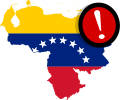| 2019 shipping of humanitarian aid to Venezuela | |||
|---|---|---|---|
| Part of the crisis in Venezuela and Venezuelan presidential crisis | |||
Top to bottom, left to right: Aid for Venezuela sent by the United States to Colombia. Packages to be sent to Venezuela prepared in Canada. United States Vice President Mike Pence visiting Colombia with boxes. | |||
| Date | 11 February 2019 Continuous donations since February 2019 | ||
| Location | |||
| Parties | |||
| Crisis in Venezuela |
|---|
 |
|
|
During the presidential crisis between the Venezuelan governments of Nicolás Maduro and Juan Guaidó, a coalition of Colombia, Brazil, the United States and the Netherlands attempted to bring essential goods as a response to shortages in Venezuela.[1] The three main bases used for the operation are: the Colombian city of Cúcuta,[2] the Brazilian state of Roraima,[3] (specifically Boa Vista and Pacaraima),[4] and the island of Curaçao, of the Kingdom of the Netherlands.[5]
Shortages in Venezuela have occurred since the presidency of Hugo Chávez, with the country experiencing a scarcity rate of 24.7% in January 2008.[6] Shortages became commonplace in the country in 2012.[6] Since Maduro attained the presidency in 2013, he has denied that there was a humanitarian crisis in the country and refused international aid, making conditions in Venezuela worse.[7] Maduro blamed the shortages on an economic war being waged by foreign adversaries, such as the United States,[8] and claims that the problems in Venezuela are due to the economic sanctions against the state-run oil company PDVSA.[9]
Guaidó and Miguel Pizarro made partial delivery of the first shipment of humanitarian aid to the Association of Health Centers (ASSOVEC) on 11 February 2019.[10][11]
On 23 February 2019, a joint operation from all coalition countries by land and sea attempted to deliver humanitarian aid to Venezuela.[12][13] At the Colombia–Venezuela border, the caravans were tear-gassed or shot at with rubber bullets by Venezuelan personnel as they crossed bridges and ultimately blocked.[14][15][16] According to a report released by the Office of the Inspector General at the U.S. Agency for International Development only 8 out of 368 tons of aid reached the country.[17] In a December 2019 survey by Venezuelan pollster Meganalisis, 85.5% of respondents said that they did not receive support from international humanitarian aid, 7.9% said they did receive aid and 6.5% were unsure if they received humanitarian aid.[18]
- ^ Torrado, Santiago (6 February 2019). "Los militares venezolanos bloquean un puente que Colombia quiere usar para trasladar ayuda humanitaria" [The Venezuelan military blocks a bridge that Colombia wants to use to move humanitarian aid]. El País (in Spanish). Retrieved 20 February 2019.
- ^ "Maduro bloquea así el puente por donde debe entrar la ayuda de EE.UU" [Maduro thus blocks the bridge where US aid must enter]. El Comercio (in Spanish). 6 February 2019. Retrieved 20 February 2019.
- ^ "Brasil abrirá centro de acopio de ayuda humanitaria para Venezuela" [Brazil will open collection center for humanitarian aid for Venezuela]. America TV (in Spanish). 11 February 2019. Retrieved 20 February 2019.
- ^ "Los centros de acopio de la ayuda humanitaria en Brasil serían en Boa Vista y Paracaima" [The collection centers for humanitarian aid in Brazil would be in Boa Vista and Paracaima]. Noticias al Día (in Spanish). 17 February 2019. Retrieved 20 February 2019.
- ^ "Ayuda humanitaria: Curazao se convierte en el tercer centro de acopio para Venezuela" [Humanitarian aid: Curaçao becomes the third collection center for Venezuela]. La Tercera (in Spanish). 13 February 2019. Retrieved 20 February 2019.
- ^ a b "Shortage at its highest since May 2008". El Universal. 6 January 2012. Archived from the original on 6 August 2017. Retrieved 3 December 2014.
- ^ Charner, Flora (14 October 2016). "The face of hunger in Venezuela". CNN. Retrieved 15 October 2016.
* Vyas, Kejal; Dube, Ryan (6 April 2018). "Venezuelans Die as Maduro Government Refuses Medical Aid". The Wall Street Journal. ISSN 0099-9660. Retrieved 7 April 2018.
* Glüsing, Jens (8 August 2018). "The Country of Hunger: A State of Deep Suffering in Venezuela's Hospitals". Der Spiegel. Retrieved 11 August 2018. - ^ Kohut, Meredith (17 December 2017). "As Venezuela Collapses, Children Are Dying of Hunger". The New York Times. ISSN 0362-4331. Retrieved 19 December 2017.
- ^ Nichols, Michelle (6 February 2019). "U.N. warns against politicizing humanitarian aid in Venezuela". Reuters. Retrieved 20 February 2019.
- ^ "Guaidó anunció que se hizo entrega del primer cargamento de ayuda humanitaria en el país" [Guaidó announced that the first shipment of humanitarian aid was delivered in the country]. El Universal (in Spanish). 11 February 2019. Retrieved 20 February 2019.
- ^ "Juan Guaidó entregó el primer cargamento de la ayuda humanitaria" [Juan Guaidó delivered the first shipment of humanitarian aid]. El Nacional (in Spanish). 11 February 2019. Retrieved 20 February 2019.
- ^ "Guaidó: El 23 de febrero ingresará la ayuda humanitaria a Venezuela" [Guaidó: On 23 February humanitarian aid will go to Venezuela]. El Universal (in Spanish). 12 February 2019. Retrieved 20 February 2019.
- ^ "Guaidó anuncia que la ayuda humanitaria ingresará el 23 de febrero" [Guaidó announces that humanitarian aid will enter on 23 February]. El País (in Spanish). Retrieved 20 February 2019.
- ^ Cite error: The named reference
mh2402was invoked but never defined (see the help page). - ^ Cite error: The named reference
:2was invoked but never defined (see the help page). - ^ "Watchdog: US aid to Venezuela driven by more than just need". Washington Post. 29 April 2021. Archived from the original on 30 April 2021.
- ^ "Just 8 of 368 Tons of U.S. Aid to Venezuela Actually Reached Country, Report Says". Newsweek. 29 April 2021.
- ^ "Encuestadora Meganalisis - 2 DE DICIEMBRE 2019". www.encuestadorameganalisis.com. Retrieved 9 December 2019.


